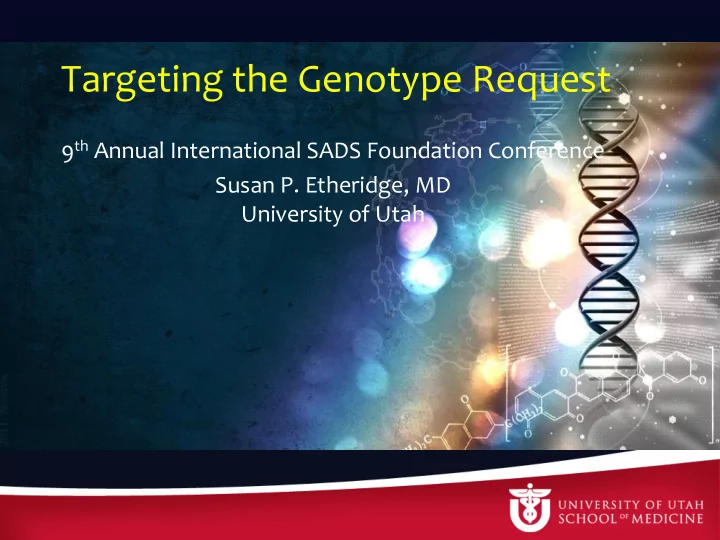

Targeting the Genotype Request 9 th Annual International SADS Foundation Conference Susan P. Etheridge, MD University of Utah
COI/Declarations • I had to learn genetics on YouTube to present this talk
A very long time later, in 1929 1929 ~ 30 years
Human Genome Project 2001 Sanger Method 1977 (1 st generation Next-generation technology) sequencing 2005 Clinical application of NGS
Genetic Testing • Rapidly increasing use in clinical realm • Identifies affected individuals • Part of picture – carriership may not predict clinical outcome – incomplete penetrance and variable expressivity – family members with same mutation, different disease burden • Genetic and nongenetic factors modify phenotype
Nongenetic Modifiers Amin and Wilde J Physiol 2013
Genetic Modifiers Amin and Wilde J Physiol 2013 Amin and Wilde J Physiol 2013
Targeted panels or whole exome/genome sequencing? How does the physician decide? “ This is a problem for clinicians because they don ’ t fundamentally understand ………..” Robert Nussbaum, MD Institute for Human Genetics UCSF broad whole whole panels panels exome genome
The Beginning
Sequencing - reading through DNA letter by letter Packaged into strands and wound is old up for easy storage in nucleus chromosome gene 4 chemicals combined into a language
Components of Human Genome
Exons • Protein coding regions of genes • Make up ~ 1% human genome • Harbor 85% of mutations with large effects on disease
• RNA a single strand • Can travel outside the nucleus Identical to DNA but lacks intron regions
RNA the recipe Travels to the ribosome – the DNA translating factory Translated into amino acids
Single nucleotide change can mean nothing or can mean disease synonymous nonsynonymous
Sanger sequencing: allowed for sequencing of DNA in a reliable and reproducible manner
Sanger Sequencing • Used for inherited arrhythmia research and clinical application • Gold standard for accuracy • Useful for hard to target areas • Validation (exome /genome findings) • Limited thoughput - slow - 2 million bases/day • Expensive
We needed something faster
SEQUENCING • Whole exome /genome sequencing • Massively parallel DNA-sequencing ~ 50 billion/day • Enormous amounts of data cheaply • Sequence genomes of many organisms • Enhancing understanding how genetic differences affect health and disease
panels • Best suited when diagnosis clear (LQTS) • Reasonable detection rate • Looking at intronic regions, and now insertions and deletions • Chasing a moving target • rapid new disease genes discovery • updating and revalidating costly /time-consuming • how much evidence required to implicate a gene? Chong Am J Hum Genet. 2015
Many panels available 7-200 genes panels Panels can be divided into those that are focused (LQTS) and those that are for broader categories of disease (arrhythmia) broad panels
whole exome • Multiple clinical features with no clear diagnosis • Cases with unusual presentations and no panel available • Currently available tests very low yield • Alternative to whole genome sequencing • Reduced – costs – turnaround times – data storage needs – informatics burdens
After Finding a Mutation • Go to the literature – association with disease – functional characterization • Rarity compared to general population? (MAF) • Alteration in protein • Return to phenotype: present in affected and absent in controls
Genetic Determination of QT Interval Rare <1% minor allele frequency (MAF) -large effect on QTc duration – disease causing ‘ Common rare ’ variants with 1 – 5% MAF and an intermediate effect on QTc duration Common variants >5% MAF - small effect on QTc duration
‘ Common rare ’ variants with 1 – 5% MAF and an intermediate effect on QTc duration • Disease-causing mutations in LQTS families with low penetrance and variable expressivity • Variants with strong modifying effects on QTc in general population • Variants associated with disease only in co-presence of a non- genetic trigger (‘ second hit ’ ) – drug-induced LQTS Priori 1999 Newton-Cheh 2009, Kannankeril 2010
Spectrum of Variants in LQTS Sauer & Newton-Cheh 2012
Genome Wide Association Study (GWAS) • DNA extracted from large populations – with/without QTc prolongation • Search genome for small variations (SNPs) occurring more in people with QTc prolongation • Identify genomic regions that may have not been previously linked to QTc duration • No information on cause
Long QT Normal QT
Manhattan Plot
Genetic Architecture of QTc and GWAS • QT interval duration has a heritable component • Genetic factors modify QT duration • 2006 a signal was identified upstream of NOS1AP associated with QT interval • Found to modify LQTS disease severity in large South African family Arking Nat Genet 2006, Crotti Circ 2009
QT Interval Associated Loci COGENT Consortium Nature Genetics 2014
Genetically elusive LQTS 4-16 LQTS 1,2,3
Conclusions 80,000,000 people in US with cardiovascular disease
often heritable
Advanced cutting age genetics/genomics technology perfectly suited to further understanding of inherited arrhythmias and SADs conditions
Recommend
More recommend